Another story about User Story Mapping, action plan mapping. Another story? The goal isn’t to find new formats for the sake of finding new formats, the goal isn’t to invent for the sake of inventing, but sometimes you find yourself in a meeting, in a workshop, in a brainstorming session and there’s a problem to solve. You’ve integrated the principles of the User Story Map. You’ve understood this tool’s ability to propose an effective visual perspective, its ability to offer participants a field of action that is auditory, visual, and kinesthetic (we touch, we manipulate), the quality of its carefully designed sequencing to establish depth in thinking as well as in tactical execution. And you find yourself in a client meeting, in a workshop, in a brainstorming session, and nothing seems more relevant than using the principles of the User Story Map, revisiting them from another angle by exploiting its qualities.
This article is only of interest if you already know action plan mapping, the User Story Map, it’s a complement to it.
A roadmap?
I recently found myself using the formalism of the User Story Map, action plan mapping, to describe and sequence a roadmap, a project portfolio. The backbone was transformed into the list of major axes that this project portfolio had to address. Then we had to fill (or not) each of these major axes. Interesting to see the different column densities (as if they were swim lanes of a Kanban). We were able to highlight the points of vigilance as is the case in a classic User Story Map.
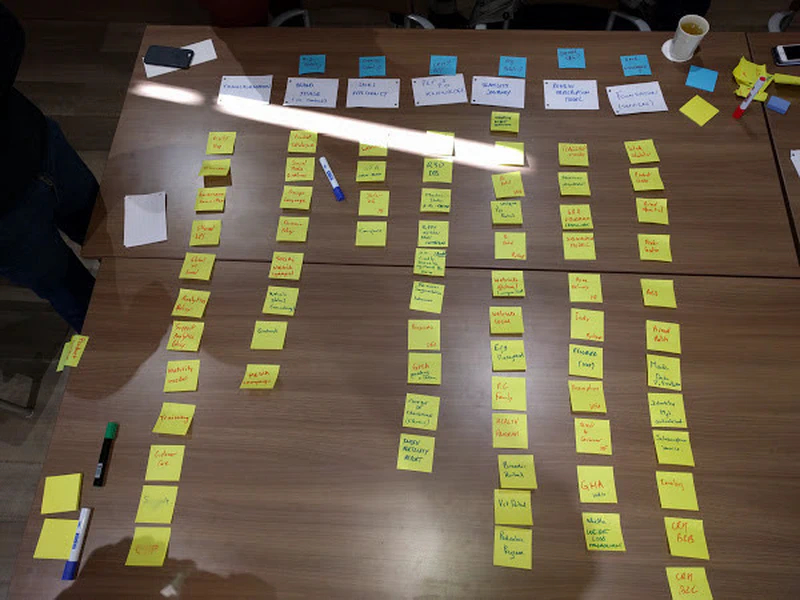
Naturally we were asked to order, prioritize by importance and by dependency each column. The User Story Map allows a group to work jointly, in parallel. Then we wanted to imagine that this portfolio should project the coming year, and instead of stages or importance gradations (Must, Should, Could, Would/Won’t) we decided to display the four upcoming semesters. That’s when it became very concrete. I’m not telling you that the estimates on capacity per quarter were good. Just telling you that it was becoming concrete. There was no question of restraining this tactical work on project sequences with constraints. And naturally we had to disseminate the elements across the different semesters de facto, and not leave them all in the first one…
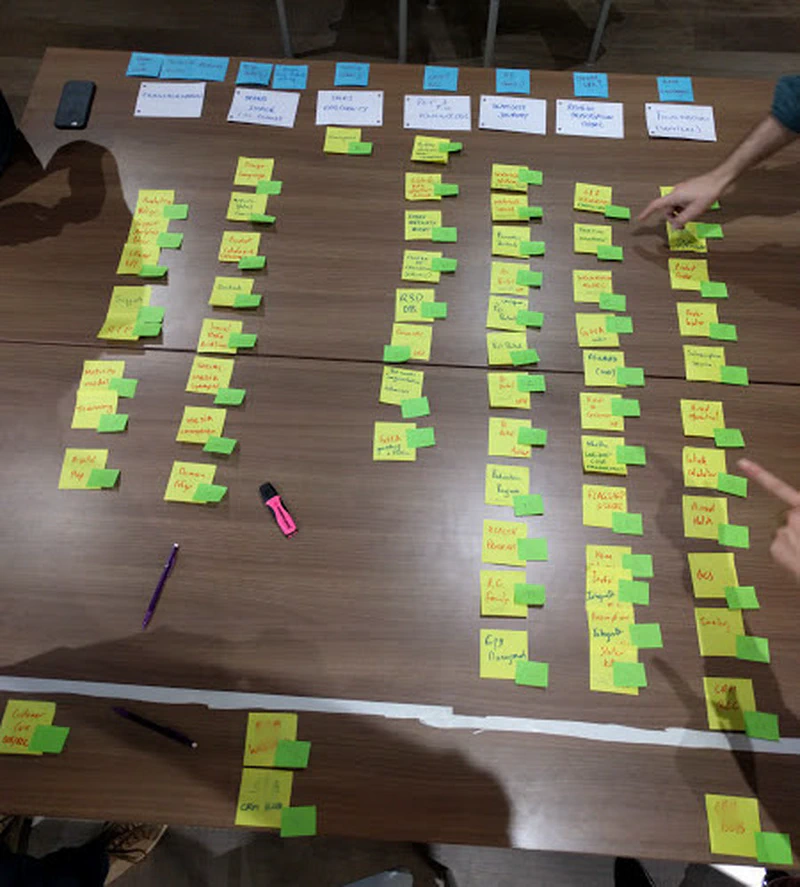
This dissemination across different semesters (quarters) of column elements again provided an interesting visual game, and also revealed inter-column dependencies, as is often the case with a User Story Map (“Impossible to do this second semester project if this other one doesn’t start until the third semester in the adjacent column because they’re linked”).
However, this approach could bring a balance between the different columns that wouldn’t necessarily be real, welcome, or logical. Indeed, each column potentially has elements in the first semester. As if we had a flat vision and each element of the backbone had its share of important priorities. As if, for example, each block of the backbone was a source of demand, they will all have important priorities, without regard to each other. Again, this isn’t necessarily real, welcome, or logical. We could use the additional line (“it hurts but it works”) as a “key strategic points” line and not balance between columns but rather highlight the key strategic points (coming from an impact mapping that we’ll see in the next article).
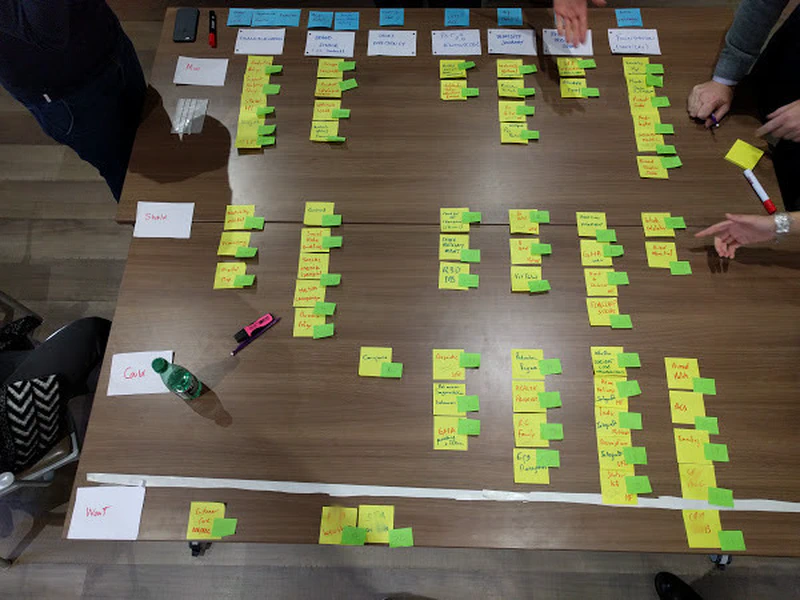
On each element we took care to make a very quick estimate (S, M, L, XL, XXL), to mark the associated business or technical components (as on Kanban cards). This gave substance to the conversations around the density of elements per semester, or on dependency issues.
- Highlight the list of project typologies.
- Make the list of projects
- Recall the points of vigilance
- Order projects by importance, value and dependency.
- Split the columns into four levels: each representing a semester.
- Complete the cards with estimation information and mark the business or technical components.
- Free up a line above the semesters to pick from the first semester elements that make strategic sense.
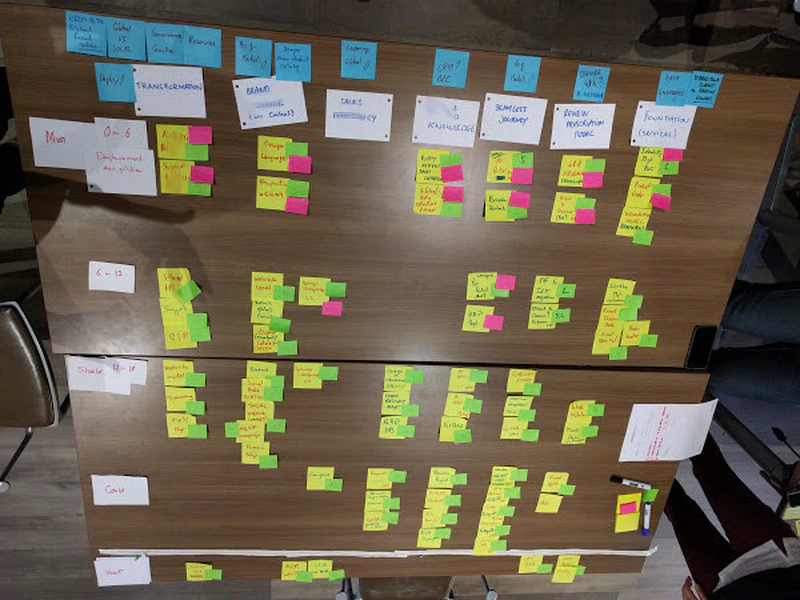
I could also have considered a subtitle for each semester that defines through a short one-sentence story the content and meaning of each line.
An interesting exercise that I’ll use again because I found (re-found) in it, at the risk of repeating myself, an effective visual perspective, a field of action that is auditory, visual, and kinesthetic, a carefully designed sequencing to establish depth in thinking as well as in tactical execution. The physical constraint (“we can’t put everything in the first line”) plays a key role as often.
An improvement plan?
Another use. Another context. I’m meeting teams that need to tell me about their process, their trades, their practices. We have little time (1H30, Frank is with me) and we’d like to quickly bring out a mapping of their practices and expectations. I tell myself that I could use action plan mapping, the User Story Map. I know it allows rapid progress, with multiple people, that it gives meaning and depth.
I start by asking the teams, as a backbone, for the major areas of their activities, and ideally in the form of a logical path: first this, then that, finally that. This determines my backbone.
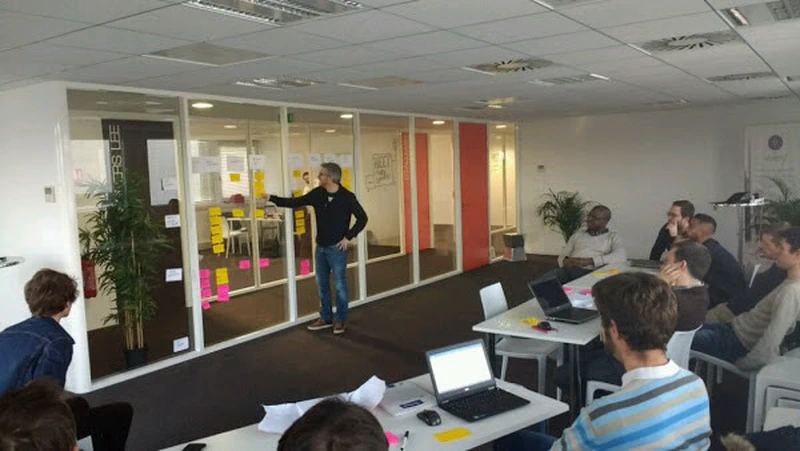
I can then ask them to note all their activities by column. Here there’s no question yet of ordering by importance. Group work allows rapid and intelligent progress.
Then I propose a line breakdown: acquired/mastered practices/activities, practices being acquired, practices to acquire, practices deemed unnecessary. In this I draw directly from the workshop proposal around Agile Fluency that Claude and I use at the raid agile in particular. It’s also the moment to add the “points of vigilance” line above the backbone. We had a “global” column for global or very cross-cutting practices. We used people’s cross-perspectives between the different columns to enrich.
Since the vertical reading doesn’t offer a logical sequence, I ask to highlight the practices deemed most important by proposing to put colored dots or a visual signal on the practices deemed important and trying to limit this distinction to a maximum of 30%.
Last step, the objective of this group is to move towards/strengthen its devops practice, I add a “to acquire for devops” line above the others to highlight practices and activities. This is ultimately again a line that highlights the strategy, rather than usually in a User Story Map, a highlighting of the MVP (minimum viable product).
(thanks Frank for the photo very good for my ego that I nevertheless strive to reduce, I was delighted with this day with you).
So:
- Describe the major typologies of activities
- Break down activities by typology
- Breakdown into: acquired practices, practices being acquired, practices to acquire, undesired practices.
- Display the points of vigilance.
- Highlight the practices deemed most important.
Comic repetition
Can I repeat myself one last time? Effective visual perspective, field of action that is auditory, visual, and kinesthetic, carefully designed sequencing to establish depth in thinking as well as in tactical execution. Action plan mapping, the User Story Map isn’t reserved exclusively for emerging products. You can use some of its qualities in other domains.